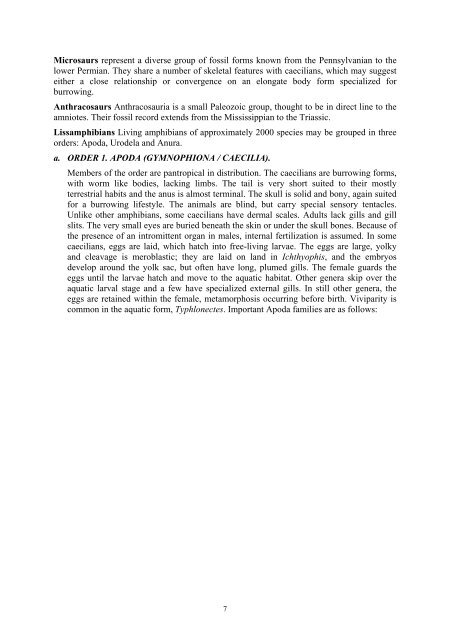Animal Diversity: Chordata
Animal Diversity: Chordata
Animal Diversity: Chordata
Create successful ePaper yourself
Turn your PDF publications into a flip-book with our unique Google optimized e-Paper software.
Microsaurs represent a diverse group of fossil forms known from the Pennsylvanian to the<br />
lower Permian. They share a number of skeletal features with caecilians, which may suggest<br />
either a close relationship or convergence on an elongate body form specialized for<br />
burrowing.<br />
Anthracosaurs Anthracosauria is a small Paleozoic group, thought to be in direct line to the<br />
amniotes. Their fossil record extends from the Mississippian to the Triassic.<br />
Lissamphibians Living amphibians of approximately 2000 species may be grouped in three<br />
orders: Apoda, Urodela and Anura.<br />
a. ORDER 1. APODA (GYMNOPHIONA / CAECILIA).<br />
Members of the order are pantropical in distribution. The caecilians are burrowing forms,<br />
with worm like bodies, lacking limbs. The tail is very short suited to their mostly<br />
terrestrial habits and the anus is almost terminal. The skull is solid and bony, again suited<br />
for a burrowing lifestyle. The animals are blind, but carry special sensory tentacles.<br />
Unlike other amphibians, some caecilians have dermal scales. Adults lack gills and gill<br />
slits. The very small eyes are buried beneath the skin or under the skull bones. Because of<br />
the presence of an intromittent organ in males, internal fertilization is assumed. In some<br />
caecilians, eggs are laid, which hatch into free-living larvae. The eggs are large, yolky<br />
and cleavage is meroblastic; they are laid on land in Ichthyophis, and the embryos<br />
develop around the yolk sac, but often have long, plumed gills. The female guards the<br />
eggs until the larvae hatch and move to the aquatic habitat. Other genera skip over the<br />
aquatic larval stage and a few have specialized external gills. In still other genera, the<br />
eggs are retained within the female, metamorphosis occurring before birth. Viviparity is<br />
common in the aquatic form, Typhlonectes. Important Apoda families are as follows:<br />
7

















